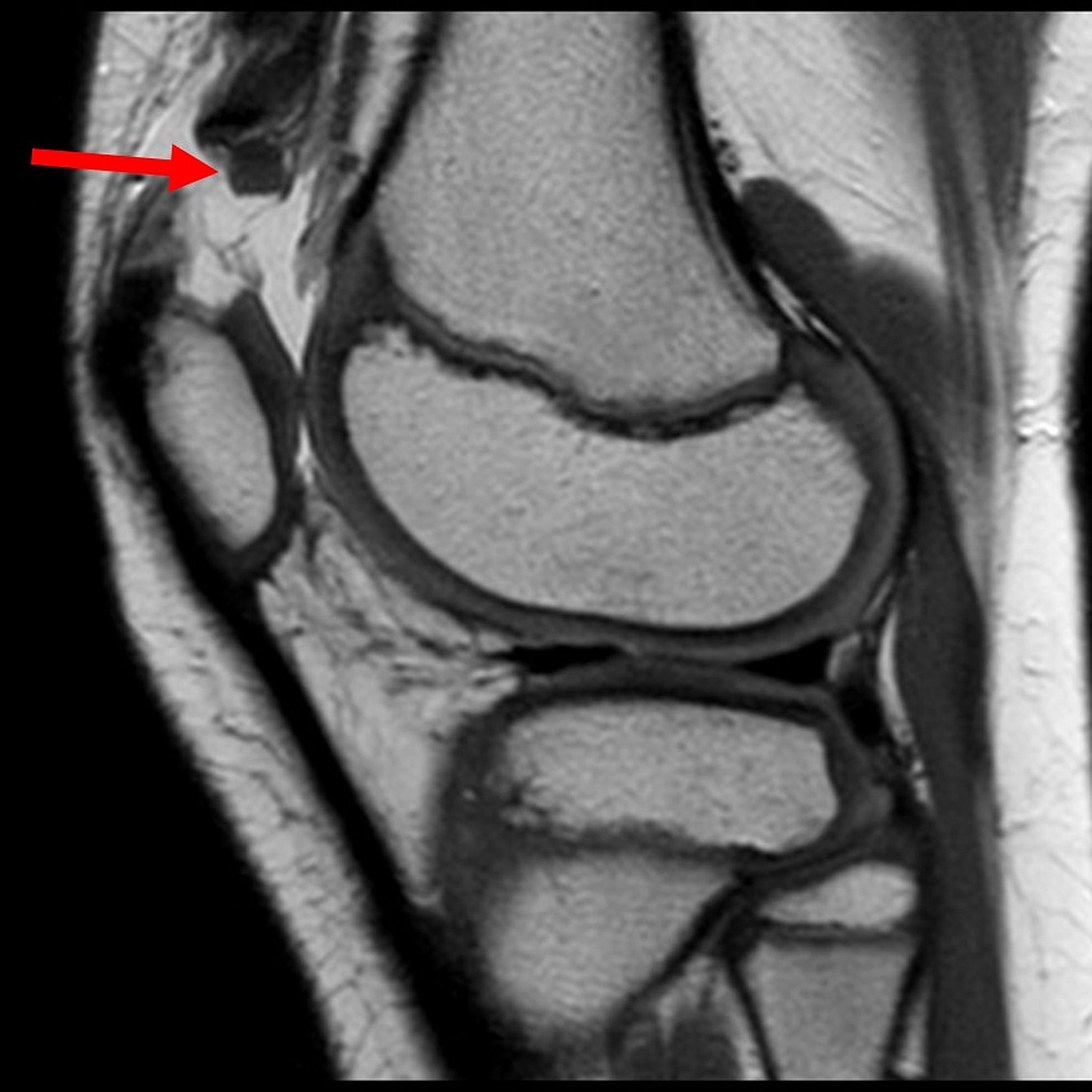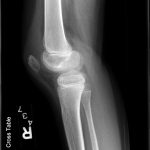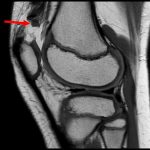An 8-year-old girl with juvenile idiopathic arthritis injured the right knee after a fall to the ground while playing kickball. She described feeling a “pop” and experienced severe pain over the anterior portion of the knee at the time of injury. She presented to the emergency department unable to bear weight on the injured extremity and had marked difficulty with knee flexion. On examination, there was tenderness over the suprapatellar area and a large knee effusion. Knee radiographs showed a cortical irregularity involving the superior patellar pole, which was presumed to be related to a remote patellar injury (Fig. 1). She was diagnosed with a juvenile idiopathic arthritis flare, was given naproxen 500 mg twice daily, and was placed in a knee immobilizer. She was advised to use crutches and to seek further orthopaedic evaluation after 3 days for the follow-up. Orthopaedic consultation was performed 3 days after the injury, and the patient was reassured that this was likely a juvenile idiopathic arthritis flare resulting from her fall and she was advised to continue with the knee immobilizer as needed.
Ten days after the injury, the patient’s mother followed up with her rheumatologist with concern about swelling and pain. The rheumatologist ordered magnetic resonance imaging (MRI) (Fig. 2).
The MRI was interpreted as showing complete disruption of the quadriceps tendon with a displaced avulsion fragment of superior patellar cartilage along with a thin sliver of subchondral bone. At the time of the surgery, there was complete rupture of the quadriceps tendon with a small osteochondral fragment attached to the proximal tendinous rupture. Surgical repair was performed with FiberWire suture passed in a Krackow configuration through the osteochondral fragment and quadriceps tendon. This suture was then passed vertically through the patella utilizing 2 bony tunnels and tied over a bone bridge distally.
The patient was first diagnosed with polyarticular juvenile idiopathic arthritis at the age of 3 years with negative antinuclear antibodies and rheumatoid factor (RF). The medications at the time of injury were methotrexate tablet (15 mg) once weekly, folic acid 1 mg daily, and infliximab infusion every 4 weeks.
The patient was placed in a long-leg cylinder cast with the knee in full extension for 3 weeks. She was then transitioned to a hinged knee brace and started physical therapy. The brace was discontinued 3 months after the surgery. Four months after the surgery, she was allowed to return to full physical activity. At that time, she continued to have a limp. At 1 year, the right knee active range of motion was from 0° to 132°. At that time, she exhibited persistent weakness of right knee extension compared with the left, as indicated by maximum leg press weight of 25 lbs (11.33 kg) and 40 lbs (18.14 kg), respectively.
Proceed to Discussion >>Reference: Yousef MA, Rosenfeld S. Complete avulsion of quadriceps tendon in a child with juvenile idiopathic arthritis: a case report. JBJS Case Connect. 2019 Dec;9(4):e0195.
Galen was the first to describe the quadriceps tendon injury in an adult athlete who was incapable of extending the knee effectively and had difficulties during walking. This injury represents 1.3% of musculoskeletal soft-tissue injuries with a peak age incidence between the ages of 50 and 70 years. It is often associated with metabolic diseases that lead to microscopic damage of the tendon blood supply and increased susceptibility to tears. Moreover, repeated microtrauma at the superior pole of the patella might be a contributing factor for quadriceps tendon injuries in athletes. Most traumatic ruptures of the quadriceps tendon are caused by an indirect, violent, eccentric muscle contraction. In the adult population, quadriceps tendon injuries tend to occur at the myotendinous junction located approximately 3 cm proximal to the superior border of the patella. However, in a child, the physis is the weakest link in the muscle-tendon-bone complex, which explains why an avulsion fracture is more likely to occur than a tendon rupture.
As quadriceps tendon injuries in children are extremely rare, such injuries are more likely to be missed. The hallmark diagnostic triad consists of acute onset pain, loss of the ability to actively extend the knee, and a palpable suprapatellar gap. A high level of suspicion, thorough history, and physical examination are absolutely essential in children with a complex medical condition because they may be more prone to such an injury. Our patient did present with the acute onset of pain and effusion and even with a history of feeling a “pop” in the knee after the fall. Unfortunately, she came with a distracting history of juvenile idiopathic arthritis that likely led the treating provider to make an assumption about the diagnosis without considering the hallmark findings associated with a quadriceps tendon rupture. Difficulty in making this diagnosis is not exclusive to the pediatric population. Previous reports have shown a high diagnostic failure up to 50% and delays in treatment ranging from days to months in an older population. Imaging studies such as ultrasound and MRI are usually used to confirm the diagnosis and evaluate the extent of disruption of quadriceps tendon fibers. These studies can help to classify these injuries into 3 types: tendinosis (referred to as jumper’s knee), partial tendon tear, and complete tendon rupture.
Juvenile idiopathic arthritis is considered an important cause of disability in pediatric population. The patient in our case report belongs to the RF-negative polyarthritis type, which is characterized by early disease onset (<6 years), female predilection, and asymmetric polyarthritis. It often affects the joints of the lower extremities, with special predilection of the knee. Although enthesitis-related arthritis is a subtype of juvenile idiopathic arthritis, it usually affects male patients after the age of 6 years with special predilection of the patellar tendon insertion at the inferior pole of the patella. Although enthesitis involves inflammation at the tendon attachment to the bone, tendon rupture has not been reported. Therefore, we believe that this should be atypical phenotypic presentation of our child who had abnormal enthesopathy affecting the patellar insertion of the quadriceps tendon, which made it more susceptible to tear. Another explanation would be the possibility of occurrence of pathological quadriceps tendon degeneration as an adverse effect of pharmacological treatment, although this has not been reported. However, a recent report described patellar tendon rupture in an 11-year-old child with granulomatous panuveitis who was receiving weekly methotrexate and monthly infliximab infusions, the same as our patient before the occurrence of the injury.
Only 3 cases of quadriceps tendon injuries have been reported in children younger than 10 years of age in the literature. All these cases involved only focal disruption of vastus lateralis muscle fibers. There were no identified predisposing factors detected in 2 cases, whereas intramuscular antibiotic injection was reported in 1 patient. Two cases were diagnosed incidentally with MRI. In the third case, the presence of avulsed bony fragment from the superior pole of the patella seen on the lateral knee radiograph raised the suspicion of possible quadriceps muscle injury and this was confirmed by ultrasound. The presence of cortical irregularity involving the superior pole of the patellar in our patient who had sustained a trauma and had acute onset of knee pain and effusion should have raised the suspicion of an injury to the extensor mechanism and led to a more thorough examination and imaging. Previous cases reported in children were partial tears treated conservatively with knee immobilization. In our patient with complete rupture, surgical repair was mandatory.
The initial incorrect diagnosis in our patient was likely due to a low index of suspicion because of the rarity of quadriceps muscle injury in children. It was thought that the patient’s symptoms were due to juvenile idiopathic arthritis flare rather than acute injury. However, a greater consideration of the presenting factors such as the fall, the audible pop, and the acute knee effusion should have led to complete a more thorough physical examination. This would have likely led to the identification of other hallmark findings such as a palpable gap in the suprapatellar region and an inability to perform straight leg raise. The authors hope that this case report will help to make providers aware of the possibility of this injury.
In conclusion, complete rupture of the quadriceps tendon is an unusual, disabling injury in children that necessitates prompt diagnosis and early surgical repair. The diagnosis might be challenging in children with complex medical conditions such as inflammatory arthritis. Therefore, a high index of suspicion and thorough physical evaluation with supplemental imaging studies as needed are essential for the diagnosis of such injuries to avoid delays in the treatment that would lead to possible suboptimal functional outcome.
Reference: Yousef MA, Rosenfeld S. Complete avulsion of quadriceps tendon in a child with juvenile idiopathic arthritis: a case report. JBJS Case Connect. 2019 Dec;9(4):e0195.
What is the diagnosis?
Osteochondroma
Benign nerve sheath tumor, probably schwannoma
Trevor disease (dysplasia epiphysealis hemimelica)
Disrupted quadriceps tendon with avulsed fragment of patellar cartilage
Chondroma of tendon sheath



 Fig. 1
Fig. 1 Fig. 2
Fig. 2